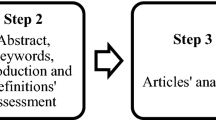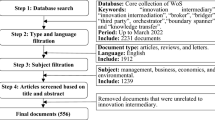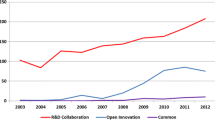Abstract
The scholars in the research domains of innovation and strategic management concerned about the appropriability for about 30 years or more. They focused on appropriability research and constantly evolving. In this paper, we analyze 30 years (1986–2016) literature on appropriability studies from Web of Science Core Collection database. A cited reference clustering map of different periods and terms co-occurrence map have been generated using bibliometric analysis and content analysis. Based on this, we study the evolutionary trajectory, mechanisms and theoretical architecture of appropriability research and explore further research directions. The results indicate that the essence of the appropriability research evolution is the perception changes in opening and sharing, value creation and value growth, and future research is focusing on role of appropriability in the platform governance, generative appropriability and the evolution of the problem-solving mechanisms.









Similar content being viewed by others
Notes
Version 5.0.R1.
Version 1.6.7.
The structured abstract labels and copyright statements were ignored.
The “Time Slicing” is set from 1986 to 2016, the “Years Per Slice” is 1 year, the “Node Types” is “Cited Reference”, and the “Selection Criteria” is “selected top 50 most cited or occurred items from each slice”, the “Minimum Spanning Tree” is used as the modified algorithm to pruning.
The cluster labels were extracted from keywords and LLR algorithms were used to generate the terminology.
We use “Fisheye View” functioning to spread out the crowded display so that we can observe each cluster’s activity in more detail than before.
We normalized scores through “Divide by mean”. It means scores of items are normalized by dividing each score by the mean score of all items.
References
Aghion, P., & Tirole, J. (1994). The management of innovation. The Quarterly Journal of Economics, 109(4), 1185–1209.
Ahuja, G., Lampert, C. M., & Novelli, E. (2013). The second face of appropriability: Generative appropriability and its determinants. Academy of Management Review, 38(2), 248–269.
Akhavan, P., Ebrahim, N. A., Fetrati, M. A., & Pezeshkan, A. (2016). Major trends in knowledge management research: A bibliometric study. Scientometrics, 107(3), 1249–1264.
Alexy, O., George, G., & Salter, A. J. (2013). Cui bono? The selective revealing of knowledge and its implications for innovative activity. Academy of Management Review, 38(2), 270–291.
Alnuaimi, T., & George, G. (2016). Appropriability and the retrieval of knowledge after spillovers. Strategic Management Journal, 37(7), 1263–1279.
Amara, N., Landry, R., & Traoré, N. (2008). Managing the protection of innovations in knowledge-intensive business services. Research Policy, 37(9), 1530–1547.
Andersen, B., & Howells, J. (1998). Innovation dynamics in services: Intellectual property rights as indicators and shaping systems in innovation. Manchester: Centre for Research on Innovation and Competition, University of Manchester.
Appio, F. P., Cesaroni, F., & Minin, A. D. (2014). Visualizing the structure and bridges of the intellectual property management and strategy literature: A document co-citation analysis. Scientometrics, 101(1), 623–661.
Appio, F. P., Martini, A., Massa, S., & Testa, S. (2016). Unveiling the intellectual origins of social media-based innovation: Insights from a bibliometric approach. Scientometrics, 108(1), 355–388.
Arora, A., Athreye, S., & Huang, C. (2016). The paradox of openness revisited: Collaborative innovation and patenting by UK innovators. Research Policy, 45(7), 1352–1361.
Arrow, K. (1962). Economic welfare and the allocation of resources for invention. The rate and direction of inventive activity: Economic and social factors (pp. 609–626). Princeton, NJ: Princeton University Press.
Arundel, A. (2001). The relative effectiveness of patents and secrecy for appropriation. Research Policy, 30(4), 611–624.
Baldwin, C. Y., & Henkel, J. (2015). Modularity and intellectual property protection. Strategic Management Journal, 36(11), 1637–1655.
Boisot, M. H. (1998). Knowledge assets: Securing competitive advantage in the information economy. Oxford: Oxford University Press.
Caloghirou, Y., Kastelli, I., & Tsakanikas, A. (2004). Internal capabilities and external knowledge sources: Complements or substitutes for innovative performance? Technovation, 24(1), 29–39.
Capaldo, A., & Petruzzelli, A. M. (2011). In search of alliance-level relational capabilities: Balancing innovation value creation and appropriability in R&D alliances. Scandinavian Journal of Management, 27(3), 273–286.
Ceccagnoli, M. (2009). Appropriability, preemption, and firm performance. Strategic Management Journal, 30(1), 81–98.
Chen, C. (2006). CiteSpace II: Detecting and visualizing emerging trends and transient patterns in scientific literature. Journal of the Association for Information Science and Technology, 57(3), 359–377.
Chesbrough, H. (2003). The logic of open innovation: Managing intellectual property. California Management Review, 45(3), 33–58.
Chesbrough, H., & Crowther, A. K. (2006). Beyond high tech: Early adopters of open innovation in other industries. R&D Management, 36(3), 229–236.
Cohen, W. M., & Levinthal, D. A. (1989). Innovation and learning: The two faces of R&D. Economic Journal, 99(397), 569–596.
Cohen, W. M., & Levinthal, D. A. (1990). Absorptive capacity: A new perspective on learning and innovation. Administrative Science Quarterly, 35(1), 128–152.
Cohen, W. M., Nelson, R. R., & Walsh, J. P. (2000). Protecting their intellectual assets: Appropriability conditions and why US manufacturing firms patent (or not) (No. w7552). National Bureau of Economic Research.
Dahlander, L., & Gann, D. M. (2010). How open is innovation? Research Policy, 39(6), 699–709.
Dechenaux, E., Goldfarb, B., Shane, S., & Thursby, M. (2008). Appropriability and commercialization: Evidence from mit inventions. Management Science, 54(5), 893–906.
Dhanasai, C., & Parkhe, A. (2006). Orchestrating innovation networks. Academy of Management Review, 31(3), 659–669.
Dosi, G., Marengo, L., & Pasquali, C. (2006). How much should society fuel the greed of innovators? On the relations between appropriability, opportunities and rates of innovation. Research Policy, 35(8), 1110–1121.
Dyerson, R., & Mueller, F. U. (1999). Learning, teamwork and appropriability: Managing technological change in the Department of Social Security. Journal of Management Studies, 36(5), 629–652.
Eck, N. J., Waltman, L., & Glänzel, W. (2017). Citation-based clustering of publications using CitNetExplorer and VOSviewer. Scientometrics, 111(2), 1053–1070.
Enkel, E., Gassmann, O., & Chesbrough, H. (2009). Open R&D and open innovation: Exploring the phenomenon. R&D Management, 39(4), 311–316.
Fey, C. F., & Birkinshaw, J. (2005). External sources of knowledge, governance mode, and R&D performance. Journal of Management, 31(4), 597–621.
Gans, J. S., & Stern, S. (2003). The product market and the market for “ideas”: Commercialization strategies for technology entrepreneurs. Research Policy, 32(2), 333–350.
González-Álvarez, N., & Nieto-Antolín, M. (2007). Appropriability of innovation results: An empirical study in Spanish manufacturing firms. Technovation, 27(5), 280–295.
Goto, Y., & Gemba, K. (2016). Implicit patent alliance acquiring the appropriability of innovation. International Journal of Technology Management, 71(3–4), 186–211.
Hamel, G. (1991). Competition for competence and interpartner learning within international strategic alliances. Strategic Management Journal, 12(S1), 83–103.
Harabi, N. (1995). Appropriability of technical innovations an empirical analysis. Research Policy, 24(6), 981–992.
Henkel, J. (2006). Selective revealing in open innovation processes: The case of embedded Linux. Research Policy, 35(7), 953–969.
Henkel, J., Schöberl, S., & Alexy, O. (2014). The emergence of openness: How and why firms adopt selective revealing in open innovation. Research Policy, 43(5), 879–890.
Henttonen, K., Hurmelinna-Laukkanen, P., & Ritala, P. (2016). Managing the appropriability of r&d collaboration. R & D Management, 46(S1), 145–158.
Hippel, E. V. (1976). The dominant role of users in the scientific instrument innovation process. Research Policy, 5(3), 212–239.
Huang, P., Ceccagnoli, M., Forman, C., & Wu, D. J. (2013). Appropriability mechanisms and the platform partnership decision: Evidence from enterprise software. Management Science, 59(1), 102–121.
Huang, F., Rice, J., Galvin, P., & Martin, N. (2014). Openness and appropriation: Empirical evidence from Australian businesses. IEEE Transactions on Engineering Management, 61(3), 488–498.
Hughes-Morgan, M., & Yao, B. E. (2016). Rent Appropriation in strategic alliances: A study of technical alliances in pharmaceutical industry. Long Range Planning, 49(2), 186–195.
Huizingh, E. K. (2011). Open innovation: State of the art and future perspectives. Technovation, 31(1), 2–9.
Hurmelinna, P., Kyläheiko, K., & Jauhiainen, T. (2007). The janus face of the appropriability regime in the protection of innovations: Theoretical re-appraisal and empirical analysis. Technovation, 27(3), 133–144.
Hurmelinna-Laukkanen, P. (2009). The availability, strength and efficiency of appropriability mechanisms–protecting investments in knowledge creation. International Journal of Technology Management, 45(3–4), 282–290.
Hurmelinna-Laukkanen, P. (2012). Constituents and outcomes of absorptive capacity–appropriability regime changing the game. Management Decision, 50(7), 1178–1199.
Hurmelinna-Laukkanen, P., Olander, H., Blomqvist, K., & Panfilii, V. (2012). Orchestrating R&D networks: Absorptive capacity, network stability, and innovation appropriability. European Management Journal, 30(6), 552–563.
Hurmelinna-Laukkanen, P., & Puumalainen, K. (2007). Nature and dynamics of appropriability: Strategies for appropriating returns on innovation. R&D Management, 37(2), 95–112.
Inkpen, A. C., & Crossan, M. M. (1995). Believing is seeing: Joint ventures and organization learning. Journal of Management Studies, 32(5), 595–618.
Kim, M. (2016). Geographic scope, isolating mechanisms, and value appropriation. Strategic Management Journal, 37(4), 695–713.
Kim, M. C., & Chen, C. (2015). A scientometric review of emerging trends and new developments in recommendation systems. Scientometrics, 104(1), 239–263.
Koput, K. W. (1997). A chaotic model of innovative search: Some answers, many questions. Organization Science, 8(5), 528–542.
Kyläheiko, K., Jantunen, A., Puumalainen, K., Saarenketo, S., & Tuppura, A. (2011). Innovation and internationalization as growth strategies: The role of technological capabilities and appropriability. International Business Review, 20(5), 508–520.
Laursen, K., & Salter, A. (2006). Open for innovation: The role of openness in explaining innovation performance among UK manufacturing firms. Strategic Management Journal, 27(2), 131–150.
Laursen, K., & Salter, A. J. (2014). The paradox of openness: Appropriability, external search and collaboration. Research Policy, 43(5), 867–878.
Levin, R. C., Klevorick, A. K., Nelson, R. R., Winter, S. G., Gilbert, R., & Griliches, Z. (1987). Appropriating the returns from industrial research and development. Brookings Papers on Economic Activity, 18(3), 783–831.
Liu, Z., Yin, Y., Liu, W., & Dunford, M. (2015). Visualizing the intellectual structure and evolution of innovation systems research: A bibliometric analysis. Scientometrics, 103(1), 135–158.
Lockett, A., & Wright, M. (2005). Resources, capabilities, risk capital and the creation of university spin-out companies. Research Policy, 34(7), 1043–1057.
Manzini, R., & Lazzarotti, V. (2016). Intellectual property protection mechanisms in collaborative new product development. R&D Management, 46(S2), 579–595.
Milesi, D., Petelski, N., & Verre, V. (2013). Innovation and appropriation mechanisms: Evidence from Argentine microdata. Technovation, 33(2), 78–87.
Miozzo, M., Desyllas, P., Lee, H. F., & Miles, I. (2016). Innovation collaboration and appropriability by knowledge-intensive business services firms. Research Policy, 45(7), 1337–1351.
Nambisan, S., & Sawhney, M. (2011). Orchestration processes in network-centric innovation: Evidence from the field. The Academy of Management Perspectives, 25(3), 40–57.
Nelson, R. R., & Winter, S. G. (1982). An evolutionary theory of economic change. Cambridge, Mass: Belknap Press.
Nieto, M., & Quevedo, P. (2005). Absorptive capacity, technological opportunity, knowledge spillovers, and innovative effort. Technovation, 25(10), 1141–1157.
Pénin, J., & Wack, J. P. (2008). Research tool patents and free-libre biotechnology: A suggested unified framework. Research Policy, 37(10), 1909–1921.
Pérez-Cano, C. (2013). Firm size and appropriability of the results of innovation. Journal of Engineering and Technology Management, 30(3), 209–226.
Pisano, G. (2006). Profiting from innovation and the intellectual property revolution. Research Policy, 35(8), 1122–1130.
Rothwell, R., Freeman, C., Horlsey, A., Jervis, V. T. P., Robertson, A. B., & Townsend, J. (1974). SAPPHO updated—project SAPPHO phase II. Research Policy, 3(3), 258–291.
Schumpeter, J. A. (1942). Capitalism, socialism and democracy. New York: Hamper Brother.
Spithoven, A., & Teirlinck, P. (2015). Internal capabilities, network resources and appropriation mechanisms as determinants of R&D outsourcing. Research Policy, 44(3), 711–725.
Teece, D. J. (1986). Profiting from technological innovation: Implications for integration, collaboration, licensing and public policy. Research Policy, 15(6), 285–305.
Teece, D. J. (2006). Reflections on “profiting from innovation”. Research Policy, 35(8), 1131–1146.
Thomä, J., & Bizer, K. (2013). To protect or not to protect? Modes of appropriability in the small enterprise sector. Research Policy, 42(1), 35–49.
Todorova, G., & Durisin, B. (2007). Absorptive capacity: Valuing a reconceptualization. Academy of Management Review, 32(3), 774–786.
Tuppura, A., Hurmelinna-Laukkanen, P., Puumalainen, K., & Jantunen, A. (2010). The influence of appropriability conditions on the firm’s entry timing orientation. Journal of High Technology Management Research, 21(2), 97–107.
van Eck, N. J., & Waltman, L. (2010). Software survey: Vosviewer, a computer program for bibliometric mapping. Scientometrics, 84(2), 523–538.
Van Eck, N. J., Waltman, L., Dekker, R., & Van den Berg, J. (2008). An experimental comparison of bibliometric mapping techniques. Paper presented at the 10th international conference on science and technology indicators, Vienna.
Van Eck, N. J., Waltman, L., Van den Berg, J., & Kaymak, U. (2006). Visualizing the computational intelligence field. IEEE Computational Intelligence Magazine, 1(4), 6–10.
Veer, T., Lorenz, A., & Blind, K. (2016). How open is too open? The mitigating role of appropriation mechanisms in R&D cooperation settings. R&D Management, 46(S3), 1113–1128.
Winter, S. G. (2006). The logic of appropriability: From Schumpeter to Arrow to Teece. Research Policy, 35(8), 1100–1106.
Xie, P. (2015). Study of international anticancer research trends via co-word and document co-citation visualization analysis. Scientometrics, 105(1), 611–622.
Xu, K., Huang, K. F., & Gao, S. (2012). Technology sourcing, appropriability regimes, and new product development. Journal of Engineering and Technology Management, 29(2), 265–280.
Yang, H., Phelps, C., & Steensma, H. K. (2010). Learning from what others have learned from you: The effects of knowledge spillovers on originating firms. Academy of Management Journal, 53(2), 371–389.
Yoshikane, F. (2013). Multiple regression analysis of a patent’s citation frequency and quantitative characteristics: The case of Japanese patents. Scientometrics, 96(1), 365–379.
Zahra, S. A., & George, G. (2002). Absorptive capacity: A review, reconceptualization, and extension. Academy of Management Review, 27(2), 185–203.
Zobel, A. K., Lokshin, B., & Hagedoorn, J. (2017). Formal and informal appropriation mechanisms: The role of openness and innovativeness. Technovation, 59, 44–54.
Acknowledgments
The authors gratefully acknowledge financial support from several sources: the National Natural Science Foundation of China (No. 71472061; No. 71172193) and Specialized Research Fund for the Doctoral Program of Higher Education of China (No. 20130161110032).
Author information
Authors and Affiliations
Corresponding author
Rights and permissions
About this article
Cite this article
Sun, Y., Zhai, Y. Mapping the knowledge domain and the theme evolution of appropriability research between 1986 and 2016: a scientometric review. Scientometrics 116, 203–230 (2018). https://doi.org/10.1007/s11192-018-2748-0
Received:
Published:
Issue Date:
DOI: https://doi.org/10.1007/s11192-018-2748-0




